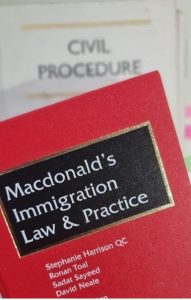 In a recent success before the First-tier Tribunal (Immigration and Asylum Chamber), Sonya Kalyan, instructed by J M Wilson Solicitors, secured the allowing of an asylum and human rights appeal for a Sierra Leonean national who had fled sustained threats, abuse, and persecution linked to both gender-based violence and imputed political opinion.
In a recent success before the First-tier Tribunal (Immigration and Asylum Chamber), Sonya Kalyan, instructed by J M Wilson Solicitors, secured the allowing of an asylum and human rights appeal for a Sierra Leonean national who had fled sustained threats, abuse, and persecution linked to both gender-based violence and imputed political opinion.
The Tribunal, presided over by a First-tier Tribunal Judge (“FTTJ”), allowed the appeal on asylum, Article 3, and Article 8 ECHR grounds, finding the appellant to be a credible witness who faced a real risk of persecution and serious harm on return to Sierra Leone.
Background and Context
The appellant’s claim centred on two interlinked narratives: her exposure to gender-based abuse and victimisation as a woman activist in Sierra Leone, and her risk arising from her association with her father, a long-standing political critic of the Sierra Leonean government residing in the United States.
Educated to university level, the appellant had engaged in campaigns promoting women’s rights and tackling sexual harassment in professional settings. She used the platform of a national beauty pageant to raise awareness of gender inequality; an event which later attracted political controversy when her father publicly accused the government of tribal bias and corruption in the selection process. His social media broadcasts, viewed widely within Sierra Leone and the diaspora, directly identified her by name.
Following these events, the appellant was subjected to sustained online abuse, threats, and harassment, forcing her into hiding. In the aftermath, her mother was targeted by unknown men believed to be linked to state authorities and later died in custody under suspicious circumstances.
Having entered the UK lawfully as a student, the appellant’s situation worsened when a former partner circulated intimate images of her online without consent; an experience which led to profound psychological trauma and reinforced her sense of exposure and danger.
The Home Office accepted the appellant’s identity and her father’s political profile but rejected her account as lacking credibility, alleging inconsistency and insufficient corroboration. It contended that she would not face persecution on return and could safely relocate within Sierra Leone.
Legal Framework
The case was determined post-Nationality and Borders Act 2022 regime, requiring the Tribunal to apply the two-stage test in section 32 NABA 2022, as clarified by JCK (s.32 NABA 2022) (Botswana) [2024] UKUT 100 (IAC).
The FTTJ summarised the legal framework by reference to:
- MAH (Egypt) [2023] EWCA Civ 216, on the proper approach to credibility assessment in asylum claims;
- Paposhvili v Belgium [2017] Imm AR 867 and AM (Zimbabwe) [2020] UKSC 17, concerning Article 3 ECHR medical claims; and
- TZ (Pakistan) & PG (India) [2018] EWCA Civ 1109, confirming that satisfaction of the Immigration Rules on private life is positively determinative of proportionality under Article 8.
The appellant’s protection claim relied on two Convention grounds:
- Imputed political opinion, derived from her father’s political activism; and
- Membership of a Particular Social Group (PSG), as a single woman in Sierra Leone, a group the Home Office accepted faced discrimination and societal disadvantage.
Representation and Advocacy
At the outset of proceedings, Sonya successfully applied for the appellant to be treated as a vulnerable witness, relying on the detailed Report prepared by a Clinical Psychologist. The Tribunal accepted that the appellant suffered from moderately severe Post-Traumatic Stress Disorder (PTSD) and Major Depressive Disorder (MDD), and accordingly applied the Joint Presidential Guidance Note No. 2 of 2010 to ensure appropriate procedural adjustments.
During the hearing, Sonya made detailed oral submissions supported by a comprehensive Appellant’s Skeleton Argument, engaging directly with both the credibility issues and the evidential gaps raised in the refusal letter.
Her submissions highlighted:
- The internal consistency and plausibility of the appellant’s account, including her explanations for delays in claiming asylum, supported by her mental health evidence;
- The gendered dimension of the persecution faced, including cyber-harassment and the misuse of intimate imagery as a tool of intimidation, contextualised by country expert evidence;
- The report of the Country Expert, which confirmed that women in Sierra Leone continue to face entrenched patriarchal barriers, limited state protection, and impunity for sexual and technology-facilitated violence; and
- The absence of any meaningful family support network or access to treatment in Sierra Leone, reinforcing both her risk and the “very significant obstacles to reintegration” under Appendix Private Life of the Immigration Rules.
In addressing the Respondent’s reliance on section 8 of the Asylum and Immigration (Treatment of Claimants, etc.) Act 2004, Sonya advanced a nuanced argument that delay in claiming asylum was explicable and did not go to the core of the claim, given the appellant’s psychological fragility and cultural stigma surrounding sexual violence.
She further submitted that the combination of the appellant’s gender, public profile, mental health, and absence of family support rendered internal relocation unduly harsh and unsafe, engaging both Articles 3 and 8 ECHR.
The Tribunal’s Findings
The Tribunal accepted the appellant’s evidence as credible, consistent, and corroborated by both the expert and medical material. The FTTJ expressly found that the appellant possessed characteristics engaging the Refugee Convention and faced a real risk of persecution on return.
In particular, the Tribunal held that:
- The appellant’s father’s political activity placed her within the scope of imputed political opinion, and her own visibility as his daughter made her identifiable to state actors;
- Single women in Sierra Leone constitute a PSG due to societal discrimination, lack of protection, and exposure to violence;
- The appellant’s previous victimisation through “revenge porn” and her trauma-related mental health conditions significantly heightened her vulnerability;
- There was no sufficiency of protection available and no viable internal relocation alternative as conceded by the Home Office; and
- Given her health and lack of support, there were very significant obstacles to reintegration, and her removal would result in unjustifiably harsh consequences, breaching her Article 8 rights.
The Tribunal found that the appellant’s treatment and anticipated harm on return would amount to persecution for Refugee Convention reasons and to a violation of Articles 3 and 8 ECHR. The appeal was therefore allowed on all grounds.
Significance of the case
This case underscores the growing recognition within the asylum framework of gender-based persecution, particularly where intersecting vulnerabilities, such as online abuse, mental health conditions, and political imputation, coalesce to create real risk on return.
It also illustrates the practical operation of the Nationality and Borders Act 2022’s evidential framework, and how careful case preparation, expert evidence, and trauma-informed advocacy can ensure that credibility is assessed holistically and fairly.
The decision affirms that women facing both gendered harm and political association risk are entitled to the full protection of the Refugee Convention, and that “revenge porn” and technology-facilitated abuse can amount to serious persecution where state protection is ineffective.
Conclusion
Through detailed case preparation, careful management of vulnerability, and persuasive submissions grounded in expert and medical evidence, Sonya Kalyan succeeded in establishing that her client’s fear of persecution was both credible and well-founded, and that removal would breach her fundamental human rights.
Sonya continues to accept instructions in complex immigration and asylum matters, including those involving challenging factual matrix and country contexts.
To instruct Sonya, please contact the chambers’ immigration clerk at immigration@halcyonchambers.com.
The views stated in this article belong to the writers in a personal capacity. No warranty is given, express or implied, in respect of the contents of this article. Nothing in this article is tendered as or is intended to be taken as legal advice and the contents should not be construed or relied upon as legal advice. Specialist legal advice should always be taken in every case noting that the application of the law may vary according to the individual facts of the case and the nature of the dispute.
 HHJ Marquand, sitting at the Wandsworth County Court, dismissed an appeal against a Civil Penalty Notice, in the total amount of £90,000 issued to a sole trader following an unannounced immigration visit to the business premises, a garage in South London. As a first breach, the maximum penalty was £45,000 per worker. Two men were found working at the garage when the Home Office visited.
HHJ Marquand, sitting at the Wandsworth County Court, dismissed an appeal against a Civil Penalty Notice, in the total amount of £90,000 issued to a sole trader following an unannounced immigration visit to the business premises, a garage in South London. As a first breach, the maximum penalty was £45,000 per worker. Two men were found working at the garage when the Home Office visited.
 Miss Gonzalez-Jaspe recently represented an applicant Father in the third set of s.8 Children Act proceedings where allegations of domestic abuse, including abuse of two children, were made against him.
Miss Gonzalez-Jaspe recently represented an applicant Father in the third set of s.8 Children Act proceedings where allegations of domestic abuse, including abuse of two children, were made against him.



